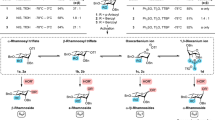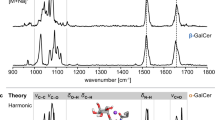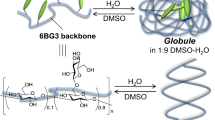Abstract
The anomeric effect is a chemical phenomenon1,2,3,4,5,6,7,8,9 that refers to an observed stabilization10 of six-membered carbohydrate rings when they contain an electronegative substituent at the C1 position of the ring. This stereoelectronic effect influences the three-dimensional shapes of many biological molecules. It can be manifested not only in this classical manner involving interaction of the endocyclic oxygen atom (O5) found in such sugars with the C1 substituent (endo-anomeric effect) but also through a corresponding interaction of the electronegative exocyclic substituent with O5 (exo-anomeric effect). However, the underlying physical origin(s) of this phenomenon is still not clear1,3,4,11,12,13,14. Here we show, using a combination of laser spectroscopy and computational analysis, that a truncated peptide motif can engage the two anomers of an isolated sugar in the gas phase, an environment lacking extraneous factors which could confound the analysis. (Anomers are isomers that differ in the orientation of the substituent at C1.) Complexes formed between the peptide and the α- or β-anomers of d-galactose are nearly identical structurally; however, the strength of the polarization of their interactions with the peptide differs greatly. Natural bond order calculations support this observation, and together they reveal the dominance of the exo- over the endo-anomeric effect. As interactions between oxygen atoms at positions C1 and C2 (O1 and O2, respectively) on the pyranose ring can alter the exo/endo ratio of a carbohydrate, our results suggest that it will be important to re-evaluate the influence, and biological effects, of substituents at position C2 in sugars.
This is a preview of subscription content, access via your institution
Access options
Subscribe to this journal
Receive 51 print issues and online access
$199.00 per year
only $3.90 per issue
Buy this article
- Purchase on Springer Link
- Instant access to full article PDF
Prices may be subject to local taxes which are calculated during checkout




Similar content being viewed by others
References
Edward, J. T. Stability of glycosides to acid hydrolysis. Chem. Ind. 1102?1104 (1955)
Eliel, E. L. & Giza, C. A. Conformational analysis.17. 2-Alkoxy- and 2-alkylthiotetrahydropyrans and 2-alkoxy-1,3-dioxanes. Anomeric effect. J. Org. Chem. 33, 3754?3758 (1968)
Romers, C., Altona, C., Buys, H. R. & Havinga, E. in Topics in Stereochemistry Vol. 4 (eds Eliel, E. L. & Allinger, N. L. ) 39?97 (Wiley Interscience, 1969)
Lemieux, R. U. Effects of unshared pairs of electrons and their solvation on conformational equilibria. Pure Appl. Chem. 15, 527?548 (1971)
Kirby, A. J. The Anomeric Effect and Related Stereoelectronic Effects at Oxygen (Springer, 1983)
Deslongchamps, P. Stereoelectronic Effects in Organic Chemistry (Pergamon, 1983)
Box, V. G. S. The role of lone pair interactions in the chemistry of the monosaccharides. The anomeric effect. Heterocycles 31, 1157?1181 (1990)
Juaristi, E. & Cuevas, G. Recent studies of the anomeric effect. Tetrahedron 48, 5019?5087 (1992)
Thatcher, G. R. J. The Anomeric Effect and Associated Stereoelectronic Effects (ACS, 1993)
Jungius, C. L. Isomeric changes of some dextrose derivatives and the mutarotation of the sugars. Z. Phys. Chem. 52, 97?108 (1905)
Salzner, U. & Schleyer, P. v. R. Ab initio examination of anomeric effects in tetrahydropyrans, 1,3-dioxanes, and glucose. J. Org. Chem. 59, 2138?2155 (1994)
Vila, A. & Mosquera, R. A. Atoms in molecules interpretation of the anomeric effect in the O-C-O unit. J. Comput. Chem. 28, 1516?1530 (2007)
Wiberg, K. B. & Murcko, M. A. Rotational barriers. 4. Dimethoxymethane ? the anomeric effect revisited. J. Am. Chem. Soc. 111, 4821?4828 (1989)
Mo, Y. Computational evidence that hyperconjugative interactions are not responsible for the anomeric effect. Nature Chem. 2, 666?671 (2010)
Eliel, E. L. & Wilen, S. H. Stereochemistry of Organic Compounds (Wiley Interscience, 1994)
Gerhards, M., Unterberg, C., Gerlach, A. & Jansen, A. Beta-sheet model systems: structures and vibrations of Ac?Phe?NHMe and its dimer. Phys. Chem. Chem. Phys. 6, 2682?2690 (2004)
Robertson, E. G. & Simons, J. P. Getting into shape: conformational and supramolecular landscapes in small biomolecules and their hydrated clusters. Phys. Chem. Chem. Phys. 3, 1?18 (2001)
Briggs, A. J., Glenn, R., Jones, P. G., Kirby, A. J. & Ramaswamy, P. Bond length and reactivity. Stereoelectronic effects on bonding in acetals and glucosides. J. Am. Chem. Soc. 106, 6200?6206 (1984)
Lemieux, R. U., Koto, S. & Voisin, D. in Anomeric Effect, Origin and Consequences (eds Szarek, W. A. & Horton, D. ) 17?29 (ACS Symposium Series, American Chemical Society, 1979)
Cramer, C. J., Truhlar, D. G. & French, A. D. Exo-anomeric effects on energies and geometries of different conformations of glucose and related systems in the gas phase and aqueous solution. Carbohydr. Res. 298, 1?14 (1997)
Takahashi, O. et al. The anomeric effect revisited. A possible role of the CH/n hydrogen bond. Carbohydr. Res. 342, 1202?1209 (2007)
Gillespie, R. J., Robinson, E. A. & Pilme, J. Ligand close packing, molecular compactness, the methyl tilt, molecular conformations, and a new model for the anomeric effect. Chem. Eur. J. 16, 3663?3675 (2010)
Acknowledgements
We thank the EPSRC for funding (GR/T26542), the Leverhulme Trust for the award of an Emeritus Fellowship (J.P.S.), the Spanish Ministry (MCINN) for a Juan de la Cierva contract (E.J.C.), the Royal Society for a USA/Canada Research Fellowship and Linacre College for a Junior Research Fellowship (T.D.V.), the STFC for the provision of equipment from the Laser Loan Pool, and the Oxford Supercomputing Centre for their services. B.G.D. is a Royal Society Wolfson Research Merit Award recipient and is supported by an EPSRC LSI Platform grant.
Author information
Authors and Affiliations
Contributions
E.J.C., P.C. and T.V.D. performed the experiments and computation. J.P.S. and B.G.D. designed the study, analysed the data and wrote the paper. All authors discussed the results and made comments on the manuscript.
Corresponding authors
Ethics declarations
Competing interests
The authors declare no competing financial interests.
Supplementary information
Supplementary Information
This file contains Supplementary Methods, Supplementary Figures 1-3 with legends, Supplementary Tables 1- 4 and additional references. (PDF 390 kb)
Rights and permissions
About this article
Cite this article
Cocinero, E., Carcabal, P., Vaden, T. et al. Sensing the anomeric effect in a solvent-free environment. Nature 469, 76–79 (2011). https://doi.org/10.1038/nature09693
Received:
Accepted:
Published:
Issue Date:
DOI: https://doi.org/10.1038/nature09693
This article is cited by
-
Exploring Hydrogen Bond in Biological Molecules
Journal of the Indian Institute of Science (2020)
-
Anomeric effect in pyranose-ring derivatives containing carbon, silicon, and germanium as anomeric centers: an ab initio systematic study
Structural Chemistry (2019)
-
IR-IR Conformation Specific Spectroscopy of Na+(Glucose) Adducts
Journal of the American Society for Mass Spectrometry (2018)
-
High conductance values in π-folded molecular junctions
Nature Communications (2017)
-
Anomeric memory of the glycosidic bond upon fragmentation and its consequences for carbohydrate sequencing
Nature Communications (2017)
Comments
By submitting a comment you agree to abide by our Terms and Community Guidelines. If you find something abusive or that does not comply with our terms or guidelines please flag it as inappropriate.



